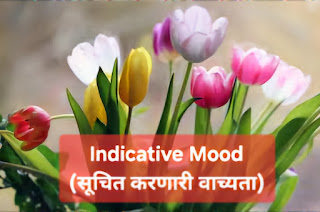Indicative Mood (सूचित करणारी वाच्यता)
Hello students! Today, we are going to learn about Indicative Mood in English.
What is Indicative Mood?
When we tell a fact, describe an event, or express a truth, we use the Indicative Mood. This is the most common type of sentence in English.
Now, let’s understand with examples.
Example 1:
My parents visited Jaipur last year.
🔹 माझे पालक गेल्या वर्षी जयपूरला गेले होते.
🍄 This sentence describes something that happened in the past.
🍄 It is in Past Simple Tense (visited is the past form of visit).
Example 2:
The moon shines at night.
🔹 चंद्र रात्री चमकतो.
🍄 This sentence expresses a universal truth.
🍄 It is in Present Simple Tense because it is always true.
Example 3:
She is going to meet her friend this evening.
🔹 ती आज संध्याकाळी तिच्या मैत्रिणीला भेटणार आहे.
🍄 This sentence expresses a planned future action.
🍄 It is in Present Continuous Tense (is going to meet – helping verb is + -ing form).
Example 4:
The train arrived late yesterday.
🔹 गाडी काल उशिरा आली.
🍄 This sentence describes an event in the past.
🍄 It is in Past Simple Tense (arrived is the past form of arrive).
Example 5:
I will help you with your homework.
🔹 मी तुला गृहपाठात मदत करीन.
🍄 This sentence talks about an offer or promise for the future.
🍄 It is in Future Simple Tense (will help – future helping verb will + base verb).
Key Reminders:
Indicative Mood expresses facts, actions, and truths.
🔮 It can be in past, present, or future tense.
🔮 Most of our daily communication uses the indicative mood.






0 Comments